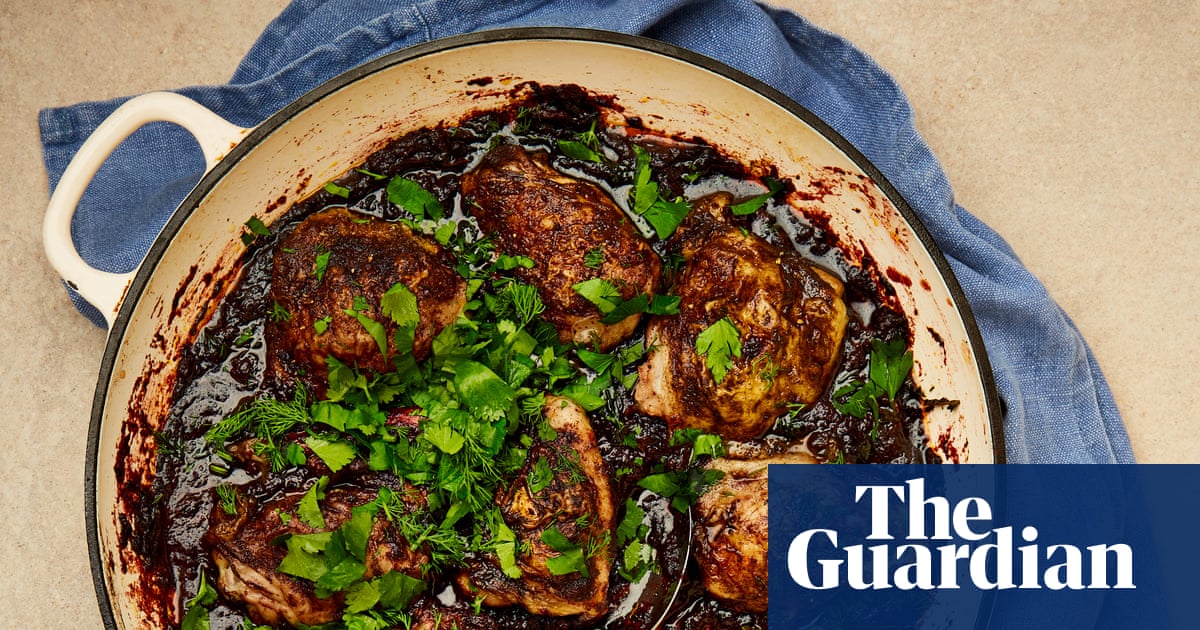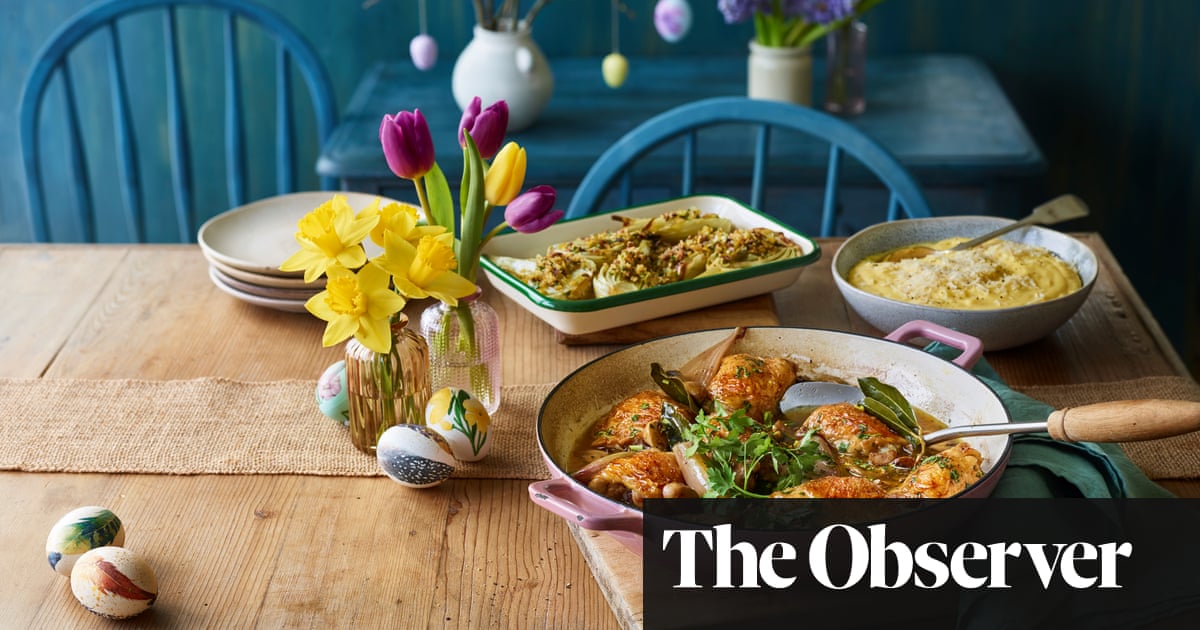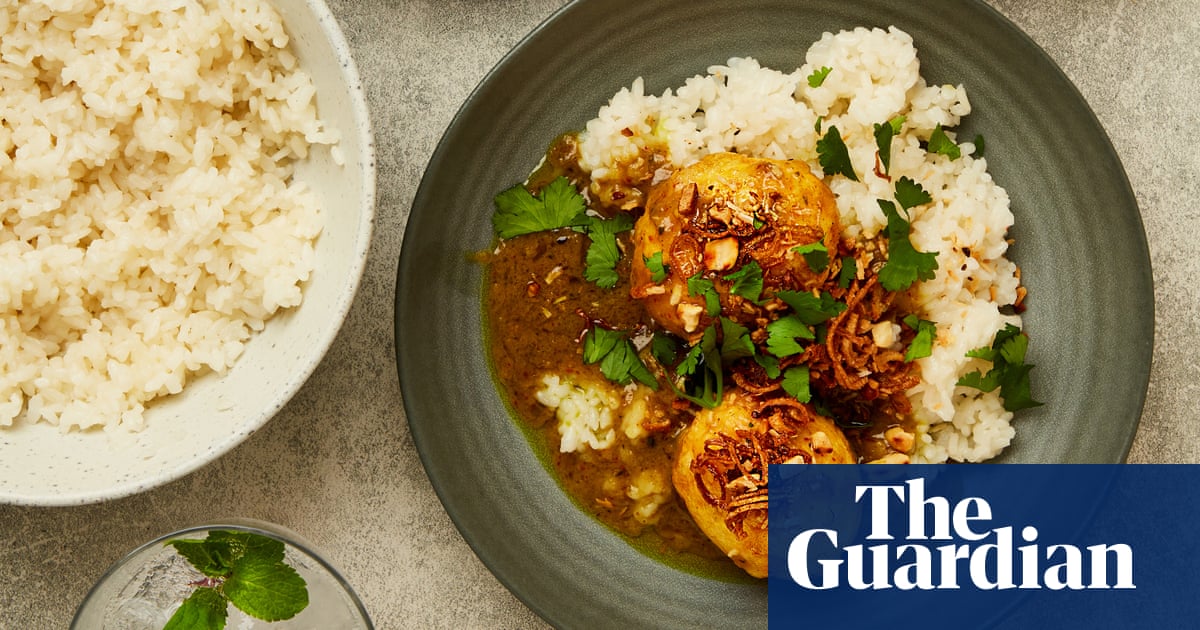
n Malaysia, it is drummed into you from a young age that a nourishing hot meal is a non-negotiable necessity, any time of the day. Economy rice outlets fulfil this need and can be found everywhere across the country. They’re an extension of the home cook’s kitchen – hearty, comforting.
The Malays have nasi campur – nasi means rice in Malay, campur means mixed. The Chinese have chap fan (mixed rice), the Indians nasi kandar and banana leaf rice, the Indonesians nasi padang. All of these have plain steamed rice front and centre, with a choice of dishes to be ladled on top. A mind-boggling array of dishes (20, 30, 50, even 100) will usually be arranged in a buffet-style setting. Those typically on offer are braises and curries alongside vegetable stir-fries and salads.
The week before lockdown in March, I opened my new all-day cafe, Nasi Economy Rice, on London’s Holloway Road. Nasi was designed to serve the food I wanted to have for a quick lunch or when I finished work. Food my mum would cook for me. A far cry from the cold lunchtime sandwich or the quick kebab more often found on our high streets. Before lockdown, my customers were going to be nearby office workers, students, local residents and football supporters going to the Arsenal stadium just up the road. Anyone looking for a quick, filling and affordable hot meal.
Here, I have chosen five recipes to provide a snapshot of Nasi’s offering, which originated from my mother’s repertoire. I still cook these at home as I can fit them easily into my busy schedule. They are very straightforward and come together in less than half an hour, except for the ribs, but I discount their cooking time in the oven as I literally walk away and do something else. To accompany these dishes I will usually add a very quick vegetable stir-fry, usually with garlic and oyster sauce. Economy rice to the core. In these uncertain times, there is an even greater need for food like this: simple, pleasurable, nostalgic and all about nutrition at its heart.
Business at Nasi continues to struggle, like so many hospitality businesses decimated by the current crisis. Nasi struggles especially because we did not have time to properly establish our brand. I haven’t given up and have instead invested in online delivery. If people cannot come to us, we will bring our Malaysian comfort food to them.
Assam fish curry
Assam in Malay means sour, usually from tamarind as it is an indigenous plant to Malaysia. This is a fantastically simple sour fish curry with a fierce chilli kick, which usually accompanies roti canai flatbreads at Indian Muslim stalls up and down the country. It keeps well and will taste even better the next day. So if cooking for two, have this curry with rice one night, and then, for a change, the next day have it with flaky roti paratha, which you will find in many supermarket freezer sections.
Serves 4
vegetable oil 4 tbsp
mustard seeds 1 tsp
fresh curry leaves 10 (optional)
onion 1 small, peeled, sliced in half then into fine semi-circles
ginger 5cm, peeled and finely chopped
garlic 2 cloves, peeled and finely chopped
chilli powder 1½ tbsp
coriander powder ¾ tbsp
turmeric powder ¾ tbsp
fennel seeds ½ tbsp
water 50ml
tamarind paste 2 tbsp
white sugar 1½ tbsp
salt 1 tbsp
tinned chopped tomatoes 200g, or 2 tomatoes, chopped into 8 pieces
water 500ml
fillets of oily fish such as mackerel, sardines, pilchard, salmon or trout 400-500g
okra 100g, tops cut off and sliced in half
Fry the oil, mustard seeds and curry leaves in a medium saucepan over medium heat. Keep the lid handy as the mustard seeds will start to pop – use the lid as a barrier between you and them.
Add the onion and fry until the edges start to become translucent, which will take about 2 minutes. Then add the ginger and garlic, and fry for another minute.
Mix the chilli, coriander and turmeric powders with the fennel seeds and the 50ml of water to make a paste. Add to the saucepan and fry over medium-low heat until fragrant and a red oil is released. This will take about 3 minutes, stirring frequently.
Add the tamarind, sugar, salt, tomatoes and water. Bring to the boil.
Once boiling, add the fish fillets and okra. Turn down the heat and simmer for 5 minutes before turning off the heat completely and serving.
Prawns in tomato sambal
This is one of the most popular dishes at Nasi Economy Rice and uses our signature tomato sambal. A satisfying dish that comes together very quickly at home, like all of the best Malaysian home-style dishes.
Serves 4
fresh red chillies 5, tops removed then roughly chopped
garlic 2 cloves, peeled
vegetable oil 5 tbsp
onion 200g, peeled and cut into large slices
dark brown sugar 1½ tbsp
salt 1 tsp
tomato puree 1 tbsp
water 2 tbsp
raw prawns 300-400g, shelled weight
Blitz the chilli, garlic and 1 tablespoon of the oil into a fine paste in a food processor.
Add the remaining 4 tablespoons of oil to a large frying pan or wok on high heat. Stir-fry the onions and the chilli-garlic paste for 2 minutes until the edges of the onions start to turn translucent.
Add the sugar, salt, tomato puree and water. Stir-fry for a minute to fully incorporate everything together.
Finally, add the prawns to the pan and cook, stirring frequently, for 2 minutes until the prawns are cooked through, then serve.
Soy-braised chicken
Every east Asian household will have its take on this recipe centred on comforting soy sauce and notes of ginger. I challenge you to find an easier dish to prepare. Including the eggs is highly recommended as they pair perfectly with the sauce.
Serves 4
vegetable oil 3 tbsp
ginger 80g, peeled and sliced into long 5cm slices
chicken thighs or drumsticks 1kg, bone in, skin removed
For the seasoning
light soy sauce 170ml
dark soy sauce 35ml
water 500ml
ground white pepper 1 tsp
dark brown sugar 80g
star anise 1
hard-boiled eggs 6-8 (boil for 7½ minutes, run under cold water till cool, then peel)
sesame oil 2 tbsp
Heat the oil in a large saucepan, add the ginger and fry over medium heat for a few minutes. Once the ginger is fragrant, add the chicken and the seasoning ingredients to the pan.
Bring to a boil, then turn down the heat and simmer uncovered for 30 minutes.
Add the whole, peeled boiled eggs for the last 5 minutes of cooking. Once you’ve turned off the heat, add the sesame oil and stir through.
Chinese barbecue ribs
If you’re a fan of char siu, you’ll love this Chinese take on barbecue ribs, which my mother made frequently during my childhood, and I continue her tradition. Sweet but not sickly, spicy and sticky, it’s the best.
Serves 4
For the marinade
ginger 5cm, peeled and finely chopped
garlic 4 cloves, peeled and finely chopped
hoisin sauce 4 tbsp
chilli powder ¼ tsp
light soy sauce 1 tbsp
white sugar 1 tsp
ground white pepper a pinch
salt ¼ tsp
oyster sauce 1 tsp (optional)
Shaoxing rice wine 1 tbsp (optional)
sesame oil 1 tbsp (optional)
For the ribs
pork ribs 1kg
vegetable oil 1 tbsp
sesame seeds 3 tbsp, toasted lightly in a frying pan
spring onions 3, finely chopped
red chilli 1, finely sliced
Mix all of the marinade ingredients together. Use half of it to thoroughly coat the ribs and leave to marinate for at least 1 hour, or preferably overnight.
Preheat the oven to 170C fan/gas mark 5. Baste the ribs with 1 tablespoon of vegetable oil before laying out in one layer on a baking tray lined with tin foil. Cook for 45 minutes.
After 45 minutes, turn the heat down to 140C fan/gas mark 3. Take out the ribs and turn them over. Add the other half of the marinade, and using gloved hands rub through to mix, then cook for a further 30 minutes.
After 30 minutes, remove the ribs from the baking tray and leave to rest for 10 minutes on a large serving plate.
Garnish with the toasted sesame seeds, spring onion and red chilli.
Five spice ragu
A fragrant comforting dish that’s also great with pasta. I think of it as a Chinese-style ragu with five spice and star anise. The beauty of it is you can use any mince you like to suit whoever you are feeding.
Serves 4
For the sauce
light soy sauce 4 tbsp
dark soy sauce ½ tbsp
sesame oil 3 tbsp
cinnamon powder ½ tsp
five spice powder ½ tsp
white sugar 1 tsp
ground white pepper ½ tsp
For the ragu
vegetable oil 100ml
onion 1 small, peeled, quartered, then cut into thin slices
star anise 1
garlic 6 cloves, finely chopped
cornflour 2 tsp mixed with 2 tsp water to make a slurry
vegan dried soy mince 150g, or 300g pork, turkey or Quorn mince
water 700ml (if using pork, turkey or Quorn mince, use 250ml water)
frozen peas 150g
fresh red chillies 2, finely sliced
fresh coriander leaves or finely sliced spring onions to serve
Mix all of the sauce ingredients together in a bowl.
Heat up the vegetable oil in a wok or large saucepan on high heat. Fry the onions with the star anise until the edges of the onions start to turn translucent, about 2 minutes. Add the garlic and stir-fry quickly for a minute until it starts to colour.
Add the sauce, cornflour slurry, soy mince, 700ml of water and the peas to the onions. Bring to a boil, then simmer gently on low heat for 5 minutes. Turn off the heat. Taste the sauce and add more salt to taste if necessary.
If using meat or Quorn mince, add to the onions and stir-fry until cooked. Then add the sauce, cornflour slurry, 250ml of water and peas. Bring to a boil, then simmer gently on low heat for 3 minutes until the peas are cooked.
Garnish with the chillies and coriander or spring onion.
Mandy Yin is the chef-owner of Sambal Shiok Laksa Bar and Nasi Economy Rice, London N7
The Observer aims to publish recipes for sustainable fish. For ratings in your region, check: UK; Australia; US












